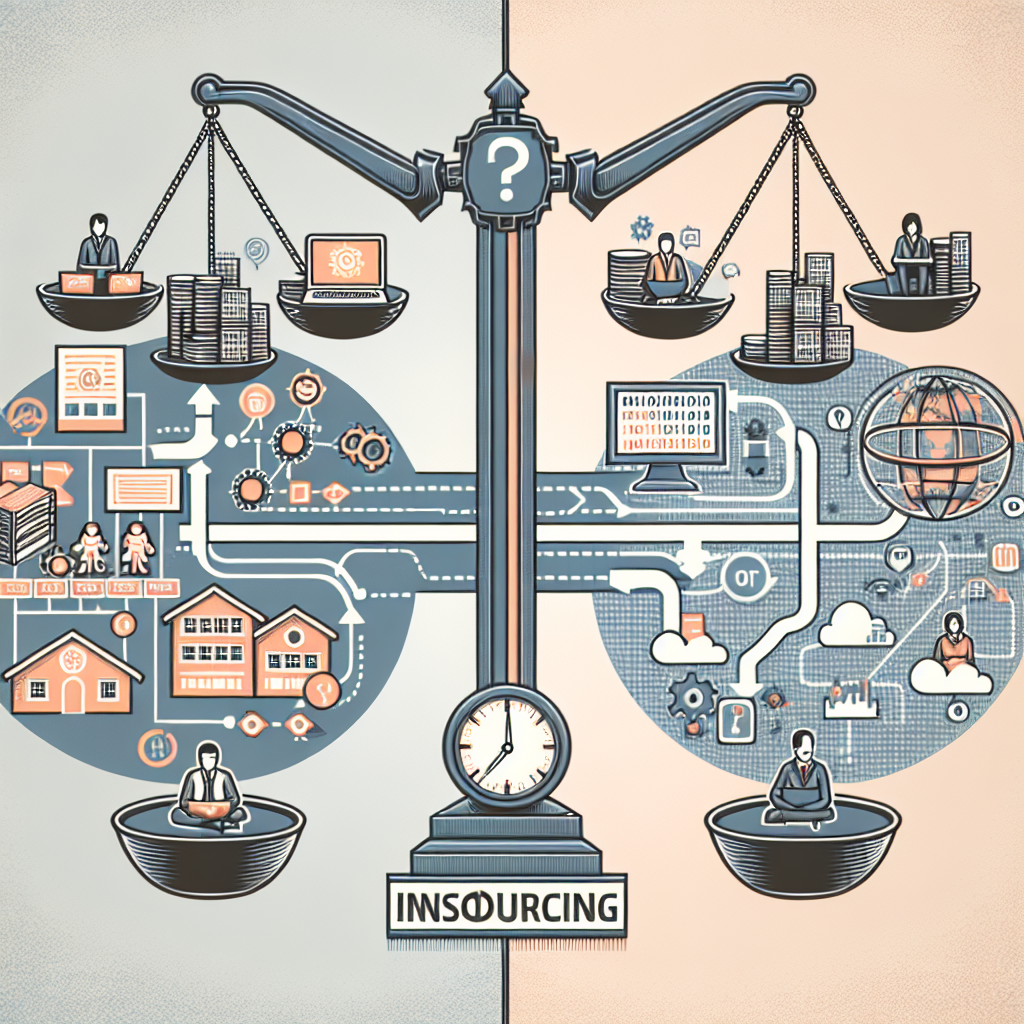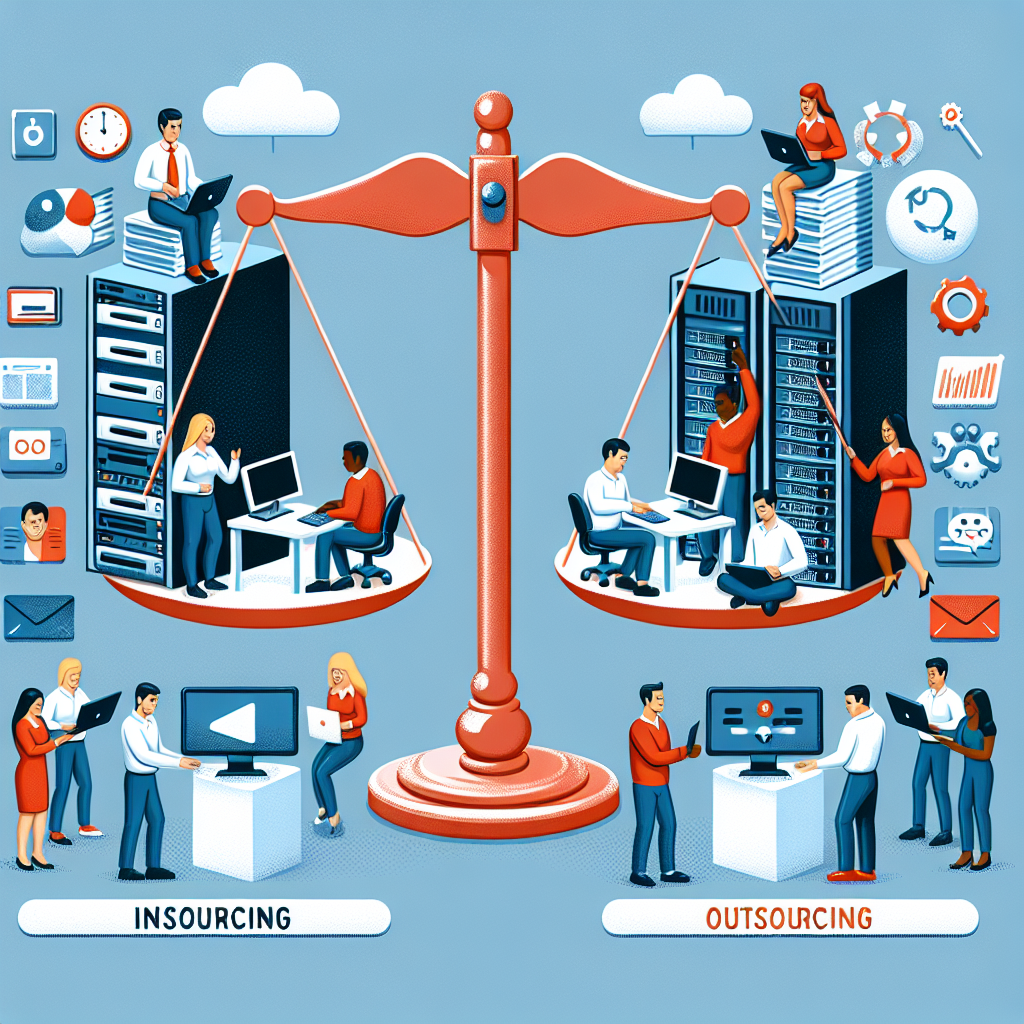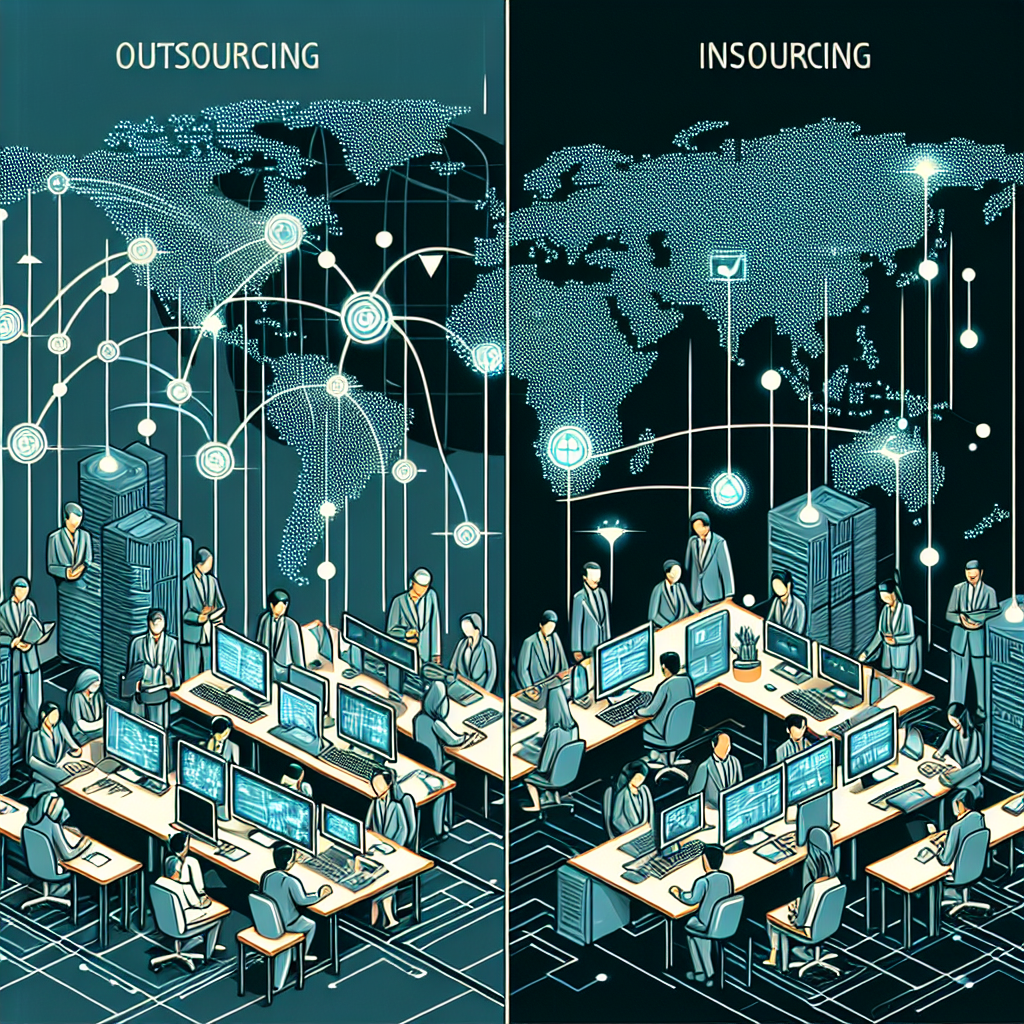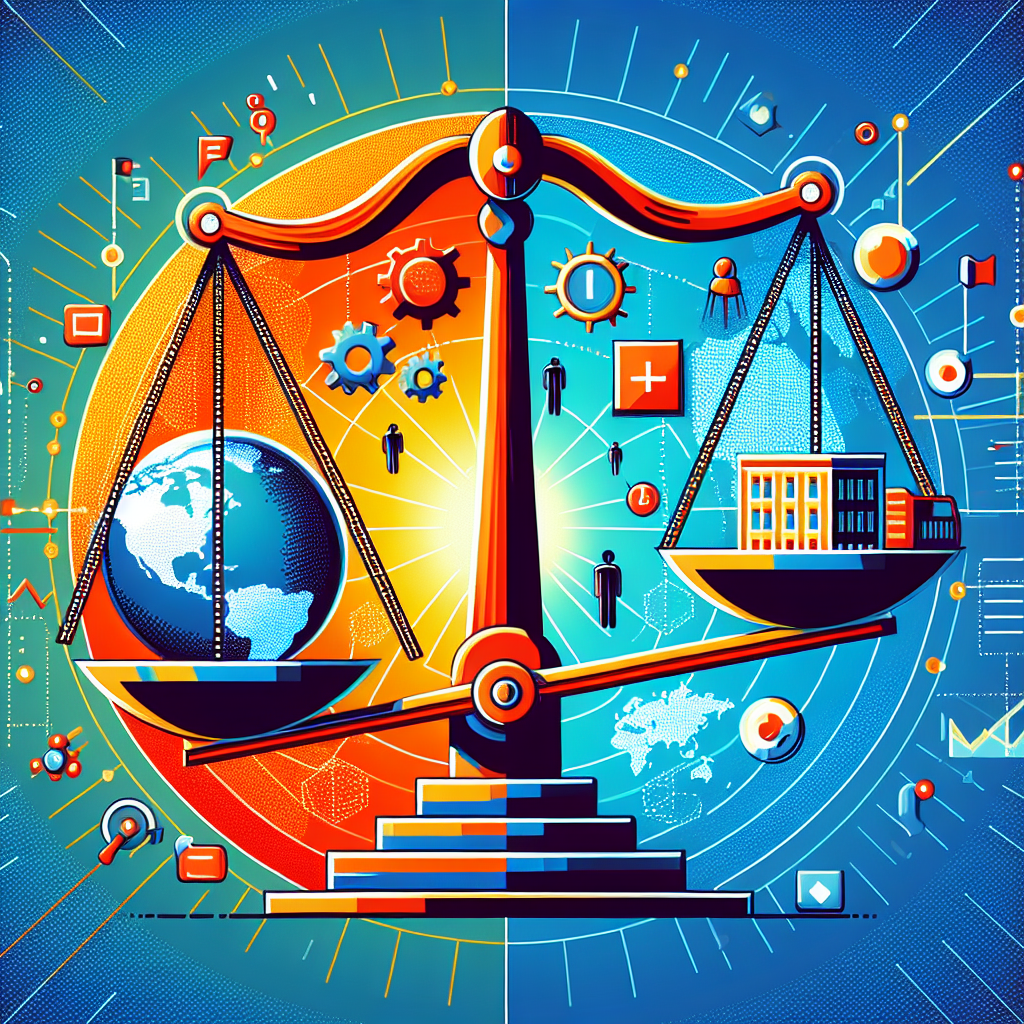Your cart is currently empty!
Tag: Insourcing

Outsourcing vs Insourcing: Making the Right Decision for Your IT Needs
In today’s fast-paced and ever-changing business landscape, companies are constantly faced with the decision of whether to outsource or insource their IT needs. Both options have their own set of advantages and disadvantages, and choosing the right approach can have a significant impact on a company’s bottom line and overall success.Outsourcing IT services involves hiring a third-party provider to handle all or part of a company’s IT functions. This can include tasks such as software development, network management, help desk support, and cybersecurity. Outsourcing can be a cost-effective solution for companies that lack the resources or expertise to handle these tasks in-house. By outsourcing, companies can access a wider talent pool, benefit from the expertise of specialized professionals, and reduce their overall IT costs.
On the other hand, insourcing involves keeping all IT functions in-house and relying on internal staff to manage and maintain the company’s technology infrastructure. Insourcing can provide companies with greater control over their IT operations, as well as the ability to tailor solutions to meet specific business needs. However, insourcing can be more costly and time-consuming, as companies must invest in hiring and training IT staff, as well as maintaining and upgrading their technology infrastructure.
So, how can companies determine whether outsourcing or insourcing is the right decision for their IT needs? The answer largely depends on the company’s specific goals, resources, and constraints. Here are some key factors to consider when making this decision:
1. Cost: Outsourcing can often be a more cost-effective solution for companies with limited budgets or those looking to reduce IT expenses. However, companies should carefully evaluate the long-term costs and benefits of outsourcing versus insourcing to ensure they are making the most financially sound decision.
2. Expertise: Outsourcing can provide access to specialized professionals with expertise in a particular area of IT, such as cybersecurity or software development. Insourcing, on the other hand, allows companies to build and develop their internal IT team to meet their specific needs and requirements.
3. Control: Insourcing provides companies with greater control over their IT operations, as they can directly manage and oversee all aspects of their technology infrastructure. Outsourcing, on the other hand, requires companies to trust third-party providers to deliver on their promises and meet their expectations.
4. Flexibility: Outsourcing offers companies the flexibility to scale their IT services up or down as needed, without the need to invest in additional resources or infrastructure. Insourcing, on the other hand, may limit a company’s ability to quickly adapt to changing business requirements.
Ultimately, the decision to outsource or insource IT services will depend on a company’s unique circumstances and objectives. Companies should carefully weigh the pros and cons of each approach, and consider factors such as cost, expertise, control, and flexibility when making this important decision. By choosing the right IT strategy for their needs, companies can ensure they are maximizing their technology investments and driving business growth and success.

IT Outsourcing vs. Insourcing: Making the Best Decision for Your Business
In today’s competitive business landscape, companies are often faced with the decision of whether to outsource their IT services or handle them in-house. Both outsourcing and insourcing have their own set of advantages and disadvantages, and it’s important for business owners to carefully consider their options before making a decision.Outsourcing IT services involves hiring a third-party provider to handle all or part of a company’s IT needs. This can be a cost-effective solution for businesses that don’t have the resources or expertise to manage their IT infrastructure internally. Outsourcing can also provide access to specialized skills and technologies that may not be available in-house.
On the other hand, insourcing IT services involves hiring and managing an in-house IT team to handle all IT needs. This can give companies more control over their IT infrastructure and ensure that their specific needs are being met. Insourcing can also foster a sense of loyalty and commitment among IT staff, leading to better long-term relationships and outcomes.
When deciding between outsourcing and insourcing, there are several factors to consider. Cost is often a major consideration, as outsourcing can be more cost-effective in the short term, while insourcing may be more cost-effective in the long run. Companies should also consider the level of control they want over their IT operations, as well as the level of expertise and resources available internally.
Another important factor to consider is the level of risk involved. Outsourcing can introduce additional risks, such as data security and confidentiality concerns, while insourcing can create risks related to staffing and training issues. Companies should carefully weigh these risks against the potential benefits of each option.
Ultimately, the decision to outsource or insource IT services will depend on the specific needs and goals of each individual business. Some companies may benefit from the cost savings and expertise that outsourcing can provide, while others may prefer the control and loyalty that comes with insourcing. It’s important for business owners to carefully evaluate their options and choose the solution that best aligns with their overall business strategy.
In conclusion, both outsourcing and insourcing have their own set of advantages and disadvantages, and there is no one-size-fits-all solution. Business owners should carefully consider their options and choose the approach that best meets their specific needs and goals. By making an informed decision, companies can ensure that their IT services are effectively managed and contribute to their overall success.

Outsourcing vs Insourcing: Which IT Strategy is Right for Your Business?
Outsourcing vs Insourcing: Which IT Strategy is Right for Your Business?In today’s fast-paced business environment, companies are faced with the decision of whether to outsource their IT services or keep them in-house. Both outsourcing and insourcing have their own set of advantages and disadvantages, and choosing the right strategy for your business can have a significant impact on its overall success.
Outsourcing IT services involves hiring a third-party company to handle all or part of your IT needs. This can include tasks such as software development, network management, and technical support. Outsourcing is often chosen by companies looking to reduce costs, access specialized expertise, and improve efficiency. By outsourcing IT services, businesses can focus on their core competencies and leave the technical aspects to the experts.
On the other hand, insourcing involves keeping all IT functions within the company and having them managed by in-house staff. This allows for greater control over IT operations, as well as the ability to tailor services to meet the specific needs of the business. Insourcing is often chosen by companies that have the resources and expertise to handle IT services internally, or those that prioritize data security and confidentiality.
When deciding between outsourcing and insourcing, it is important to consider the specific needs and goals of your business. Here are some factors to consider when making this decision:
1. Cost: Outsourcing IT services can often be more cost-effective than hiring and training in-house staff. However, insourcing may be more cost-effective in the long run if your company has the resources to support an internal IT team.
2. Expertise: Outsourcing allows businesses to access specialized expertise and stay up-to-date on the latest technologies. Insourcing may be more suitable for companies that require full control over their IT operations and have the expertise to manage them internally.
3. Flexibility: Outsourcing offers greater flexibility in scaling IT services up or down based on the needs of the business. Insourcing may provide more control and customization options, but may be less flexible in terms of resource allocation.
4. Data security: Insourcing can provide greater control over data security and confidentiality, as sensitive information is kept within the company. Outsourcing may pose a higher risk of data breaches, as information is shared with a third-party provider.
In conclusion, both outsourcing and insourcing have their own set of advantages and disadvantages when it comes to IT strategy. It is important for businesses to carefully evaluate their needs and goals in order to determine which strategy is right for them. Ultimately, the decision should be based on factors such as cost, expertise, flexibility, and data security. By choosing the right IT strategy, businesses can effectively leverage technology to drive growth and success.

Outsourcing vs. Insourcing: Making the Right Choice for Your IT Needs
Outsourcing vs. Insourcing: Making the Right Choice for Your IT NeedsIn today’s digital age, businesses of all sizes rely heavily on technology to operate efficiently and effectively. As a result, the decision of whether to outsource or insource IT services has become increasingly important. Each option has its own set of advantages and disadvantages, and the right choice for your business will depend on a variety of factors.
Outsourcing IT services involves hiring a third-party provider to handle various aspects of your company’s technology needs. This can include everything from software development and network maintenance to help desk support and cybersecurity. Outsourcing can offer several benefits, such as cost savings, access to a wider range of expertise, and the ability to scale services up or down as needed. Additionally, outsourcing can free up your internal IT team to focus on more strategic initiatives.
On the other hand, insourcing IT services involves hiring and managing an in-house team of IT professionals to handle all technology needs. Insourcing can provide greater control over the quality and security of your IT infrastructure, as well as foster a stronger sense of company culture and collaboration. However, insourcing can also be more expensive and time-consuming, as you will need to invest in hiring, training, and retaining skilled IT professionals.
When deciding whether to outsource or insource your IT services, consider the following factors:
1. Cost: Outsourcing can often be more cost-effective than hiring and maintaining an in-house IT team, particularly for small to medium-sized businesses with limited resources.
2. Expertise: Outsourcing can provide access to a wider range of technical expertise and specialized skills that may not be available in-house.
3. Scalability: Outsourcing allows for greater flexibility and scalability, as you can easily adjust services based on your business needs.
4. Control: Insourcing offers greater control over the quality and security of your IT infrastructure, as well as the ability to align IT initiatives with overall business goals.
Ultimately, the decision to outsource or insource your IT services will depend on your business goals, budget, and the level of control you desire over your technology operations. It may be beneficial to consult with a professional IT services provider to assess your specific needs and determine the best course of action for your business. By carefully considering the pros and cons of each option, you can make an informed decision that will support the long-term success of your company.

Outsourcing vs Insourcing: Making the Right Choice for Your IT Needs
Outsourcing vs Insourcing: Making the Right Choice for Your IT NeedsIn today’s fast-paced business environment, companies are constantly looking for ways to streamline their operations and cut costs. One of the key decisions that organizations often face is whether to outsource their IT needs or keep them in-house through insourcing. Both options have their own set of pros and cons, and choosing the right approach can have a significant impact on a company’s bottom line.
Outsourcing IT services involves hiring a third-party vendor to handle all or part of a company’s IT needs. This can include tasks such as software development, network management, help desk support, and cybersecurity. By outsourcing these services, companies can benefit from access to specialized expertise, reduced labor costs, and increased flexibility to scale up or down as needed. Additionally, outsourcing can free up internal resources to focus on core business activities.
On the other hand, insourcing IT services means keeping all IT operations within the company’s own infrastructure. This approach can provide greater control and security over sensitive data, as well as more direct communication between IT staff and other departments. Insourcing also allows for better alignment between IT and business objectives, as internal teams are more familiar with the company’s culture and goals.
When deciding between outsourcing and insourcing IT services, there are several factors that companies should consider. One key consideration is cost – while outsourcing may initially seem like a more cost-effective option, hidden fees and unexpected expenses can quickly add up. Companies should also evaluate the level of control and flexibility they require over their IT operations, as well as the level of expertise available internally.
Ultimately, the decision to outsource or insource IT services will depend on the unique needs and priorities of each individual company. Some organizations may benefit from the cost savings and specialized expertise that outsourcing offers, while others may prefer the control and security of keeping IT operations in-house. Companies should carefully weigh the pros and cons of each option before making a decision, and consider consulting with IT experts to help guide their choice.
In conclusion, choosing between outsourcing and insourcing IT services is a critical decision that can have a significant impact on a company’s overall success. By carefully evaluating the costs, benefits, and risks associated with each option, companies can make an informed choice that best aligns with their business objectives and IT needs. Whether outsourcing or insourcing is the right choice will ultimately depend on the specific requirements and goals of each individual organization.

Outsourcing vs. Insourcing: Which is Right for Your IT Needs?
In today’s fast-paced business world, companies are constantly seeking ways to stay ahead of the competition and improve their efficiency. One way they are doing this is by outsourcing or insourcing their IT needs. But which option is right for your company?Outsourcing IT services involves hiring a third-party company to handle your IT needs, such as software development, network maintenance, and help desk support. This can be a cost-effective option for many companies, as it allows them to access specialized skills and expertise without the need to hire and train in-house staff. It also allows companies to focus on their core business activities while leaving the IT tasks to the experts.
On the other hand, insourcing IT services means keeping all IT functions in-house and relying on your own team of IT professionals to handle all technical tasks. This can provide greater control and flexibility over IT operations, as well as better security and confidentiality of sensitive data. However, it can also be more expensive and time-consuming to maintain an in-house IT team, as it requires ongoing training, equipment upgrades, and salary expenses.
So, how do you decide which option is right for your company? Here are some factors to consider:
1. Cost: Outsourcing IT services can be more cost-effective in the short term, as you only pay for the services you need. However, insourcing can be more cost-effective in the long run if you have a consistent need for IT services and can keep your team busy with ongoing projects.
2. Expertise: Outsourcing allows you to access a wider range of expertise and skills, as you can choose a company with the specific skills you need for each project. Insourcing may limit your access to specialized skills, unless you invest in ongoing training for your team.
3. Control: Insourcing provides greater control over IT operations and allows you to tailor IT solutions to your specific needs. Outsourcing may involve relinquishing some control to a third-party provider, which can be a concern for some companies.
4. Flexibility: Outsourcing can provide more flexibility in scaling IT services up or down as needed, without the need to hire or lay off staff. Insourcing may require you to maintain a certain level of staff regardless of fluctuations in IT needs.
Ultimately, the decision to outsource or insource your IT needs will depend on your company’s specific requirements, budget, and long-term goals. It may be beneficial to consult with IT experts or conduct a cost-benefit analysis to determine which option is best for your company. Whichever option you choose, it’s important to regularly review and reassess your IT strategy to ensure that it continues to meet your company’s evolving needs.

Outsourcing vs. Insourcing: Finding the Right Balance for Your IT Needs
In today’s fast-paced business environment, companies are constantly faced with the decision of whether to outsource or insource their IT needs. Outsourcing refers to hiring external vendors to handle specific IT functions, while insourcing involves keeping all IT functions in-house. Both options have their pros and cons, and finding the right balance for your IT needs is crucial for the success of your business.Outsourcing IT services can be a cost-effective solution for businesses looking to reduce overhead expenses. By outsourcing, companies can access specialized expertise and cutting-edge technology without having to invest in expensive infrastructure and training. This can lead to increased efficiency and innovation, as external vendors are often more agile and can provide solutions more quickly than in-house teams.
On the other hand, outsourcing can come with its own set of challenges. Communication barriers, time zone differences, and cultural differences can all impact the effectiveness of an outsourced IT team. Additionally, security concerns and the risk of data breaches are major considerations when outsourcing sensitive IT functions to external vendors.
Insourcing, on the other hand, offers businesses more control and oversight over their IT operations. By keeping IT functions in-house, companies can ensure that their data is secure and that their IT team is aligned with the overall goals and objectives of the business. Insourcing also allows for more collaboration and integration between IT and other departments, leading to greater efficiency and productivity.
However, insourcing can be more costly and time-consuming than outsourcing. Companies must invest in recruiting, training, and retaining top IT talent, as well as maintaining and upgrading IT infrastructure. This can be a significant financial burden for small to medium-sized businesses with limited resources.
So, how can businesses find the right balance between outsourcing and insourcing for their IT needs? The key is to carefully evaluate the specific requirements of your business and weigh the pros and cons of each option. Consider factors such as the complexity of your IT needs, the level of expertise required, and the sensitivity of the data being handled.
For businesses with limited resources and a need for specialized expertise, outsourcing may be the best option. By partnering with reputable IT service providers, companies can access a wide range of skills and resources that may not be available in-house. Outsourcing can also free up internal resources to focus on core business activities and strategic initiatives.
On the other hand, for businesses with sensitive data and a need for tight security controls, insourcing may be the better choice. By keeping IT functions in-house, companies can ensure that their data is protected and that their IT team is fully aligned with the goals and objectives of the business. Insourcing can also foster a culture of innovation and collaboration within the organization.
In conclusion, finding the right balance between outsourcing and insourcing for your IT needs is essential for the success of your business. By carefully evaluating your requirements and weighing the pros and cons of each option, you can make an informed decision that aligns with your business goals and objectives. Whether you choose to outsource, insource, or a combination of both, the key is to find a solution that meets your specific needs and enhances the overall efficiency and effectiveness of your IT operations.

IT Outsourcing vs. Insourcing: Which is Right for Your Business?
In today’s fast-paced and technology-driven world, businesses are constantly faced with the decision of whether to outsource their IT needs or keep them in-house. Both outsourcing and insourcing have their own set of advantages and disadvantages, and it can be a challenging task to determine which option is the best fit for your business. In this article, we will explore the differences between IT outsourcing and insourcing and provide some insights to help you make an informed decision.Outsourcing IT services involves hiring a third-party service provider to handle your company’s IT needs. This can include tasks such as software development, network management, cybersecurity, and technical support. Outsourcing can offer several benefits, such as cost savings, access to specialized expertise, and scalability. By outsourcing IT services, businesses can focus on their core competencies and leave the technical aspects to professionals who are dedicated to providing high-quality services.
On the other hand, insourcing IT services involves building an in-house IT team to handle all of your company’s technical needs. Insourcing can provide greater control over the IT processes and can foster a sense of ownership and accountability among employees. Insourcing also allows for better integration with other departments and can lead to greater alignment with the overall business goals.
When deciding between IT outsourcing and insourcing, it is important to consider several factors. One of the main considerations is cost. Outsourcing can often be more cost-effective, as it eliminates the need to hire and train in-house staff. However, insourcing can be more cost-effective in the long run, as it allows for greater control over expenses and can lead to a more streamlined IT infrastructure.
Another factor to consider is expertise. Outsourcing allows businesses to access a wide range of specialized skills and knowledge that may not be available in-house. This can be particularly beneficial for small businesses that may not have the resources to hire a full-time IT team. However, insourcing can provide greater control over the quality of work and can lead to a more cohesive IT strategy.
Ultimately, the decision to outsource or insource IT services will depend on your business’s unique needs and goals. It is important to carefully evaluate the pros and cons of each option and consider factors such as cost, expertise, and control. By taking the time to assess your IT requirements and align them with your business objectives, you can make an informed decision that will help your company thrive in today’s competitive marketplace.
